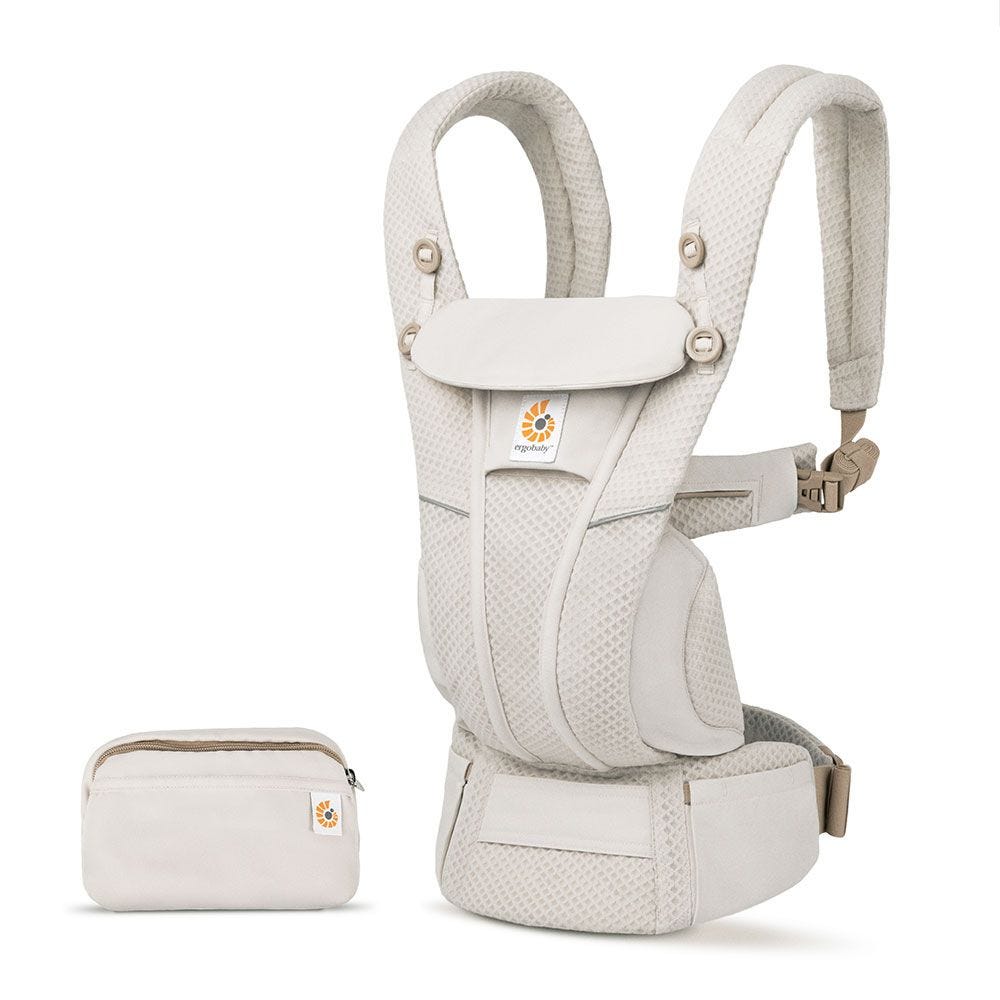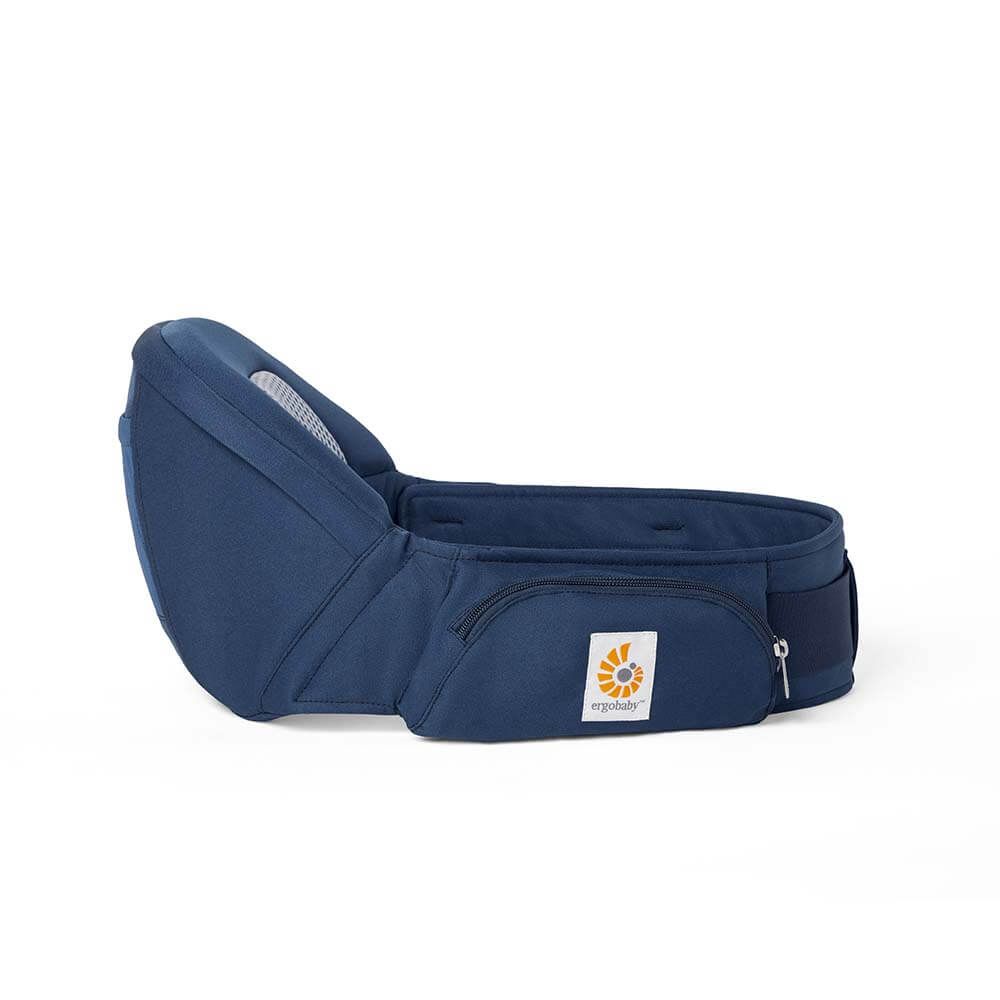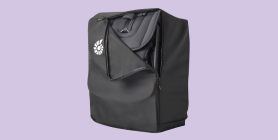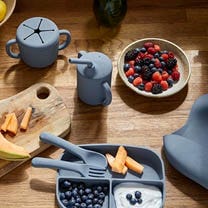Page 9 - Ergobaby
Your pelvic floor is a group of muscles that you might not think about very often, but if they aren’t strong and flexible, they can sorely impact your quality of life. This area of the body fulfils many important functions, as it is directly connected to our abdominal, back and respiratory muscles. The pelvic floor enables us to walk upright, closes our pelvis downwards, supports our internal organs and ensures that the bladder and bowel sphincters function. It also contributes to pleasurable sex. Today we talk about the role of the pelvic floor during pregnancy, during birth and afterwards. In this blog you will learn about the positive benefits that targeted pelvic floor training can have for you during pregnancy and afterwards.
What role does the pelvic floor play during pregnancy?
Your pelvic floor changes during pregnancy. On the one hand it needs stability to hold the uterus with the baby and on the other hand it needs a certain elasticity to give way to the increasing weight of the
Have you ever wondered how newborn babies can intuitively suckle on their mother's breast/chest? How can they do it so instinctively? It's simple: sucking and suckling are innate behavioural mechanisms in young babies.
Even in the womb, growing babies can be observed sucking their thumbs during ultrasound examinations. According to scientific studies, sucking has a calming effect and can even help to reduce unpleasant or painful sensations. It's no wonder that in some families a dummy is considered the "Holy Grail" that must not be lost under any circumstances.
But what about a dummy? Is it healthy for your little one’s teeth development? And if so, what does the perfect dummy look like? Or is it best not to teach your baby to suck on a dummy, because it is so difficult to wean off later? And what if your child prefers to suck their thumb rather than a dummy?
A dummy. Yes, or no?
When it comes down to it, the choice is entirely yours. Whether your baby is breast/chest, bottle fed or using
Even though your baby's head is the biggest and heaviest part of your child - their skull is still very sensitive. Hidden beneath the soft baby fuzz are movable, deformable plates that protect your baby's developing brain. However, they can also flatten if your little one lies on their back too often and can't turn their head. This is when the so-called flat head syndrome can occur. Although this can be treated, it is much easier to prevent it. That's why Katrin Ritter a Midwife and Babywearing and Sleep Specialist for Ergobaby explains more about how flat head syndrome occurs in babies and which Ergobaby products can help you prevent it.
What is flat head syndrome?
If babies lie on their backs for several hours a day, for example in a stroller, bassinet or car seat/infant carrier, and at night as recommended, they can develop what is known as flat head syndrome. Also known as positional plagiocephaly or brachycephaly, flat head syndrome can sometimes begin before birth when pressure is
We love denim, especially when your favourite jeans fit perfectly! There is almost no other piece of clothing that fits so comfortably to spend your day in. And now you can get that feeling for your baby carrier too. A little bonus: You're also doing something for your ecological footprint! Because Ergobaby has teamed up with the New Denim Project®, a sustainable design lab in Guatemala, to create the Ergobaby Omni Dream Denim. The ultra-soft design of our popular baby carrier is made from 100% upcycled denim fabric, helping to reduce waste in the textile industry and conserve important resources on our planet.
The first Ergobaby baby carrier made from 100% cotton denim.
The New Denim Project®, a family-run design lab in Guatemala City, promotes an environmentally conscious approach to fashion production. They are committed to transforming our economy from a linear system to a circular system.
What does that look like?
Old denim is given a new lease of life. By mechanically breaking down
Why can breastfeeding be painful?
Breastfeeding can have some of the weirdest side effects, as Sandra, our lactation consultant, knows all too well. Unfortunately, pain is also part of it and unfortunately the reason is not always as clear as if the baby is teething. Some mothers also complain about the formation of milk blisters on the nipple. In today's breastfeeding advice you can find out what is behind this and what to do in this case.
What do milk blisters on the nipple mean?
There are many different reasons why a blister can develop on the nipple. Often a small skin forms above a milk duct on the nipple. This is accompanied by a tingling sensation in the breast and pain when breastfeeding. The milk is hindered in its flow by the membrane and can even lead to milk stasis. After breastfeeding, a white spot or milk-filled blister often remains on the nipple.
If you're lucky, the bubble will pop open on its own while breastfeeding. You can support this “self-opening” before breastfeeding
Breast/chest feeding is very beneficial for your baby. That's why World Breast/Chest Feeding Week is being celebrated again from the 1st until the 7th August celebrate all things feeding.
This year's theme is "Breast/chest feeding at work - know your rights". If you are planning to return to work, training, or education whilst breast/chest feeding, the NHS states you can ask your employer or college for flexible working hours arranged around your breast/chest feeding needs.
While we're on the subject of "work", we thought we'd share with you some insights from our Ergobaby employees’ personal experiences with breast/chestfeeding to give you some top tips.
Secret 1: "Don't listen to others, listen to your own feeling".
"I was always afraid to eat anything when I was breastfeeding because my mum had told me not to eat onions, garlic etc. to avoid my baby getting tummy aches. But I realised quickly that I had to do what felt right for me. After all, as mamas we have instincts in us and therefore
Healthy baby skin - how to protect your child's sensitive skin.
Soft, elastic, and resistant: the skin is our largest organ and fulfils numerous vital functions. The skin of babies and toddlers is much more sensitive and permeable than adult skin and therefore needs special care. In the following blog, you will learn how baby and children's skin differs from adults and how you can take good care of it.
What is the difference between baby skin and adult skin?
Your baby's skin is much thinner than your own. In addition, the uppermost cell layer and the horny layer have a looser structure and are therefore less resistant to pathogens and pollutants. That is why baby's skin reacts more sensitively to environmental influences. From birth and in the early stages of life, the pH value of the baby's skin is neutral. The natural acid mantle, which is an additional protective function, forms after a few weeks and regenerates much more slowly in older children than in you. Since the top layer of baby's
Summer! Finally! Many of us will be planning on taking a trip at some point this year, whether that's a long break overseas or a short trip close to home. Our UK sleep specialist Gemma Coe is a mum of two and is a certified baby and child sleep consultant. She helps families all over the world develop healthy sleep habits. Today, Gemma talks to us about getting your baby’s sleep after traveling back on track.
I'm writing this blog two days after returning from a camping trip in France with my family so it's great timing. I heeded my own advice whilst on our trip. "Try really hard not to worry about sleeping too much and just concentrate on having fun. Holidays are precious". So yes, this happened. The kids had late nights, fun nights and there was zero recognition of the bedtime routine!
That was great whilst away, suited us really well. We could eat together as a family in the evenings and even have a little lie-in (which is unusual as my son is an early bird).
I do have to say I was a
Should you co-sleep with your baby?
Sleeping close to your little one seems innocent enough. After all, what's sweeter than cuddling up all night with your baby? But bed-sharing and co-sleeping with baby have become heated topics, and with so many opinions on either side, it can be hard to figure out the healthiest choice for your family. Our midwife Katrin Ritter tells you all the things you need to know about co-sleeping to make the best decision for you and your family.
What is co-sleeping or bed sharing?
Co-sleeping means that parents and children sleep in the same bed or in the same room. There are different types of co-sleeping:
- Room-sharing: Your baby or child sleeps in their own bed or in a cot in the same room as you. For the first six months your baby should be in the same room as you when they're asleep, both day and night.
- Bed-sharing: Your baby or child sleeps in the same bed as you.
- Side sleeping: Your child sleeps in a cot attached to your bed so that they can sleep
Hip dysplasia baby: detect early, treat correctly.
"The main thing is for the baby to be healthy" is so often said when parents to be are asked the preferred gender for the expected baby. However, not everything always goes smoothly with the physical development of your baby in the womb. It is not at all uncommon - in about 2-4% percent of newborns - for congenital or acquired hip dysplasia to develop. If this occurs, baby then suffers from a malformation/maturation disorder of the acetabulum (socket).
Our expert Stephanie Schmitz, functional senior physician for paediatric orthopaedics at the Asklepios Klinik Bad Abbach, the teaching hospital of the University of Regensburg, explains how early screening and modern therapies can help with this diagnosis and avoid late consequences.
How does hip dysplasia develop?
In Central Europe, acquired hip dysplasia occurs at a rate of 2%- 4%, with girls being affected up to five times more frequently. The risk of developing hip dysplasia increases



















